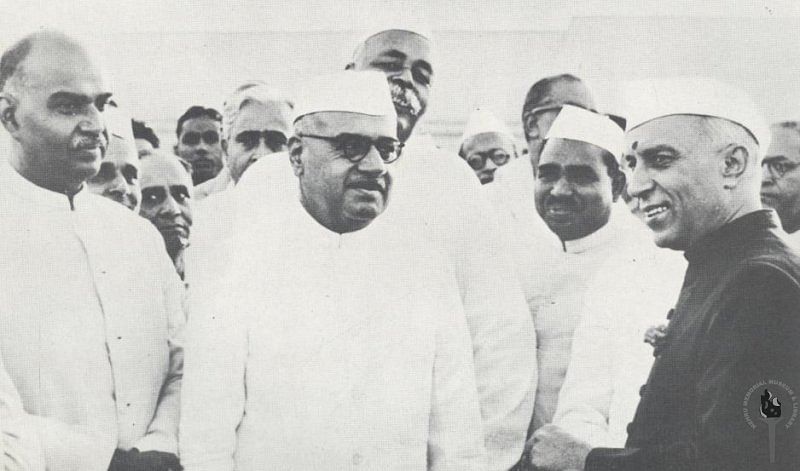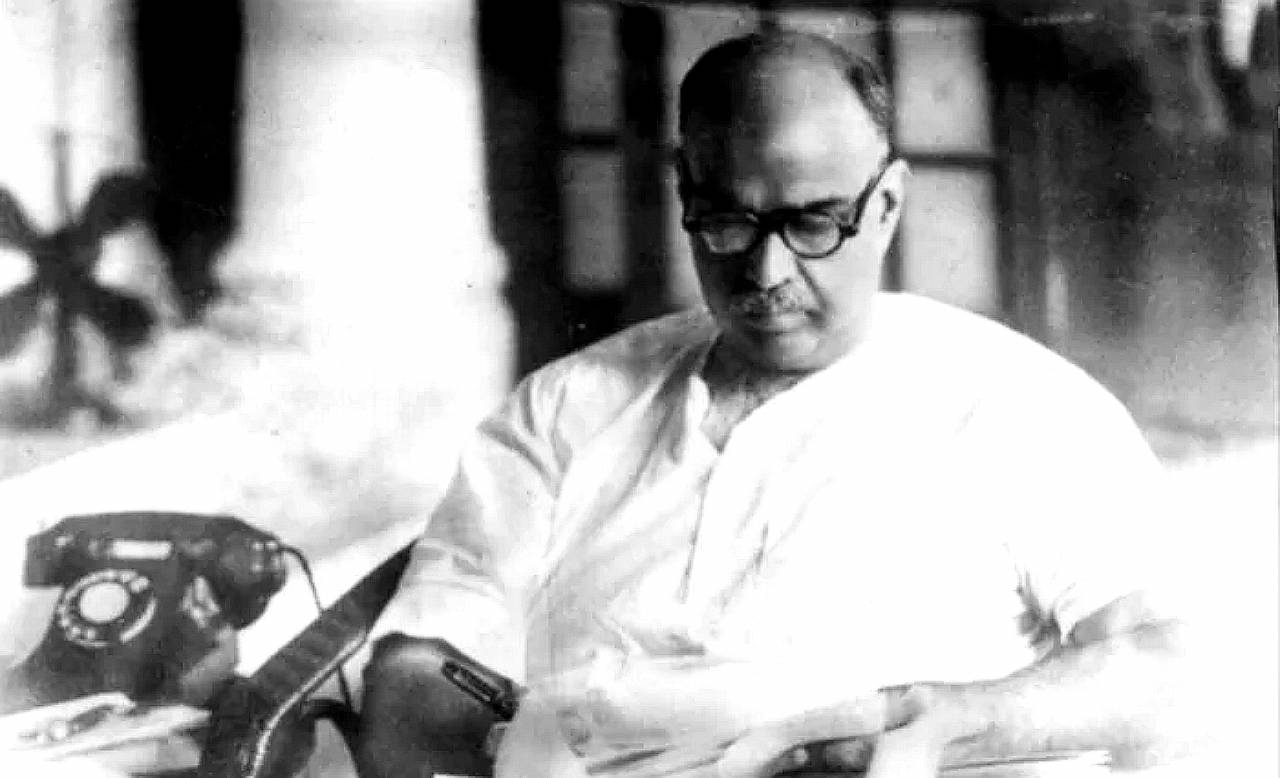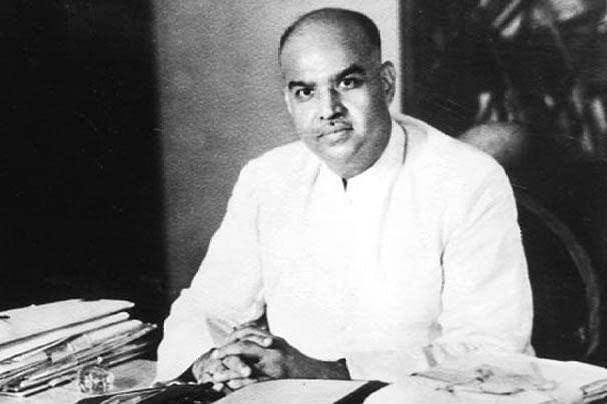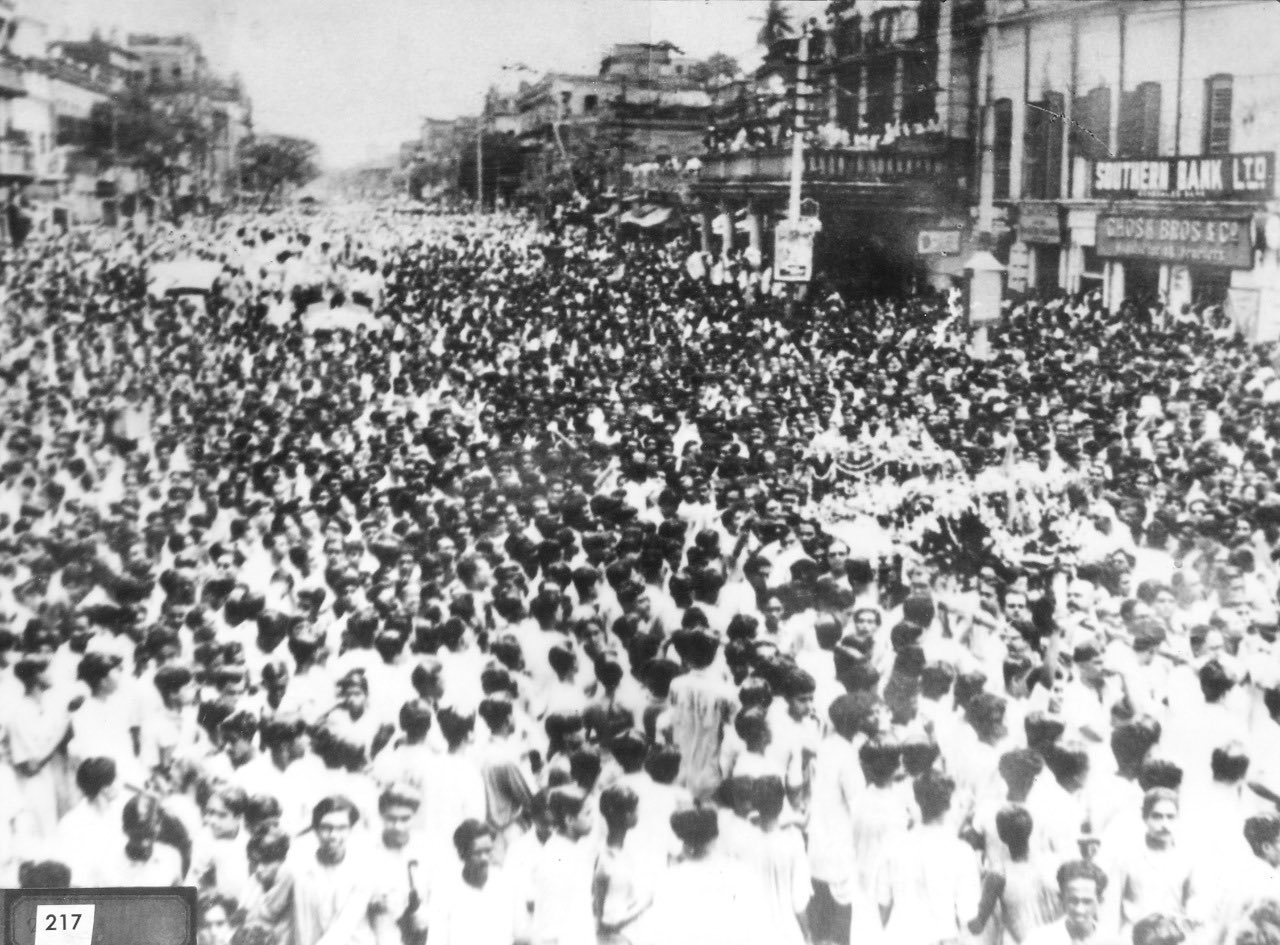Sanatan Articles
Satyaagrah
Written on
Satyaagrah
Written on
Satyaagrah
Written on
Satyaagrah
Written on
Satyaagrah
Written on
JOIN SATYAAGRAH SOCIAL MEDIA
Mysterious death of the tallest leader Syama Prasad Mookerjee in Kashmir: He was strong critic of Nehru and founder of Bharatiya Jana Sangh (BJP today)

Sixty-eight years ago in 1953 on this day, Dr Syama Prasad Mookerjee – one of the country’s tallest leaders – was mysteriously found dead while he was under detention by the government of Jammu and Kashmir.
Dr Mookerjee, a former minister in undivided Bengal and later a minister in Prime Minister Jawaharlal Nehru’s cabinet, was a prominent opposition leader and a fierce critic of Nehru and his so-called secular politics. Dr Mookerjee, the founder of Bhartiya Jana Sangh that later evolved into the BJP, was a champion of Hindu nationalism and expectedly became a target for “liberal-secular” leaders such as Jawaharlal Nehru.
Dr Syama Prasad Mookerjee was the first to demand the full integration of Jammu and Kashmir into Indian territory and had launched the famous “Ek Vidhan, Ek Pradhan, Ek Nishan” movement in the early 1950s. He had led a nationwide campaign against the Nehru government over the special status granted to Jammu and Kashmir.
 From left front row Syama Prasad Mookerjee Jairamdas Doulatram and Jawaharlal Nehru - Commons |
Dr Mookerjee was arrested illegally by the police on the orders of Sheikh Abdullah’s government on May 11, 1953. A month later, the Hindu leader died during his detention in June 1953 at a prison in Srinagar.
However, many believe that there was a conspiracy behind Mookerjee’s death. The circumstances of his death were mysterious and though many questions were raised the then political powers never launched a detailed, impartial investigation into his death.
|
The journey, the illegal detention and the death:
Mookerjee, a leader from West Bengal, was a member of Nehru’s cabinet until he resigned in 1950 to protest the Nehru-Liaquat Pact, a treaty meant to secure the security and rights of minorities in both countries.
The Jans Sangh founder then became one of the most vocal critics of Nehru and associated himself with the Jammu and Kashmir issue, for which he ultimately sacrificed his life — Mookerjee died in Srinagar on 23 June under mysterious circumstances.
It all began in April 1952 when Prem Nath Dogra, a leader of the Praja Parishad Party of Jammu and Kashmir, visited New Delhi and met Mookerjee, urging him to help the ongoing agitation in the state.
The parishad’s key demand was that Jammu and Kashmir’s accession to India should be finalised through a resolution adopted by the state’s Constituent Assembly. It demanded that the state should adopt the provisions of the Constitution of India related to fundamental rights, citizenship, financial integration, Supreme Court, emergency powers of President and abolition of customs duty, conduct of elections and acceptance of supremacy of Indian flag and policy regarding liberation and occupation of Pakistan-held territory.
Mookerjee suggested that Prem Nath Dogra put all the facts before Nehru. Dogra tried to meet Nehru, but couldn’t secure an appointment.
 |
Mookerjee in J&K
Disappointed over the developments in Delhi, Dogra went back and under his leadership, the Praja Parishad decided to hold a convention of its workers in Jammu on 9-10 August 1952. He invited several MPs and senior political leaders from Delhi, including Mookerjee.
The Jana Sangh founder addressed a mammoth public meeting in Jammu where he gave the famous clarion call for one Constitution.
During this visit, he also met Sheikh Abdullah and had a long talk with him, but there was no positive breakthrough. In the beginning of December 1952, Praja Parishad started a peaceful satyagraha in Jammu and Kashmir. The movement was supported by the Bharatiya Jana Sangh.
In support of this movement, Mookerjee decided to write letters to Nehru after the first annual session of Bharatiya Jana Sangh from 29 to 31 December 1952.
Meanwhile, the situation deteriorated in Jammu and Kashmir. Mookerjee received many letters about the atrocities in the state. On 27 February 1953, Durga Das Verma, general secretary of Praja Parishad in Jammu, sent him a telegram, copies of which were also sent to many other political leaders in Delhi as well as the President, the PM and the home minister of India.
“Merciless and shameless beating to doctor Omprakash, president, City Parishad; Shri Gopal Dass, publicity secretary, and four others by the authorities. Forced removal to Srinagar insulting and intimidating; Gopal Dass arm fractured,” the telegram read. “Hunger strike on since five days. Public sentiments are running high. Pray intervention.”
A day before this telegram, a meeting of the leaders of Bharatiya Jana Sangh, the Hindu Mahasabha and the Akali Dal was held in Delhi and it was decided that 5 March 1953 will be observed as “Jammu and Kashmir Day” throughout the country in support of the agitation by the Praja Parishad in the erstwhile state.
On that day, Mookerjee attended a public meeting at Company Bagh in New Delhi where he said a joint committee had decided that a satyagraha would be started, over the Praja Parishad’s demands, both in Delhi and at Pathankot in addition to other districts of Punjab.
On 6 March, another meeting was held in Delhi on the same issue for which Mookerjee was arrested for violating prohibitory orders under Section 144. He was, however, released by the Supreme Court.
 |
The J&K satyagraha
As the satyagraha began, Mookerjee began travelling extensively. He addressed several well-attended public meetings and press conferences in several cities and towns, including Delhi, Jaipur, Ajmer, Bhopal, Gwalior and Indore.
The intelligence reports of the home ministry had then clearly said the satyagraha attracted a fairly large crowd (National Archives of India, D.I.B. reports-Praja Parishad agitation in Delhi. New Delhi: Ministry of States f.no. 8,(20)-k/53).
Dr Mookerjee had decided to visit Kashmir in 1953 to observe a hunger strike to protest the law that prohibited Indian citizens from settling in Jammu and Kashmir. As per the special status granted to J&K by Nehru, no one, including the President of India, could enter into Kashmir without the permission of Kashmir’s Prime Minister. Essentially, Indians were barred from entering the state of J&K and had to carry a mandatory permit card to be allowed inside the state.
To protest this flawed arrangement, Dr Shyama Prasad Mookerjee had decided to visit Kashmir in 1953 and observe a hunger strike demanding the cancellation of the controversial provision that prohibited Indian citizens from settling in a state within their own country. Dr Mookerjee had intended to launch a civil disobedience movement against the Indian National Congress-led government by entering Jammu and Kashmir without the mandatory permit.
He had launched a protest to oppose the Indian National Congress’s decision to grant Kashmir a special status with its own flag and Prime Minister. “Ek desh mein do Vidhan, do Pradhan aur Do Nishan nahi chalenge,” said Dr Mookerjee that later went on to become a battle cry for many nationalists to oppose Nehru’s policies on Kashmir.
Mookerjee finally realised that he was left with no other option but to visit J&K. He left Delhi by train on 8 May 1953. While travelling, he addressed a public meeting at Ambala (in today’s Haryana), from where he also sent a telegram to Sheikh Abdullah in which he conveyed his desire to proceed towards J&K.
The next day, Sheikh Abdullah forwarded the telegram to the PM and the home minister in Delhi.
 |
“My objective is to see for myself the present conditions in Jammu and also to contact people there. I am exploring the possibilities of creating conditions which may expedite a peaceful settlement and restoration of good feelings and understanding among all concerned,” Mookerjee’s telegram read. “After surveying situations in Jammu, I would welcome an opportunity to meet you as well.”
On his way to Jammu and Kashmir, he went to Karnal from Ambala to address meetings at Shahabad and Nilokheri (both in present-day Haryana). On 9 May, he reached Panipat, from where his next stop was Jalandhar before he left for Amritsar.
In Amritsar, he again addressed meetings and press conferences on 10 May, and spent the night. He reached Pathankot on 11 May, and Sheikh Abdullah had replied to his telegram by then, describing his proposed visit as “inopportune”.
Along with Dr Mookerjee, his aides Guru Datt Vaid, Atal Bihari Vajpayee, Tek Chand, Balraj Madhok and a few journalists had travelled to Jammu and Kashmir.
Mookerjee reached Jammu and Kashmir from Pathankot. But as soon as he entered, he was arrested by the then Inspector General of Police, Jammu and Kashmir, in the presence of Maulana Masudi, then general secretary of Sheikh Abdullah’s National Conference. He was arrested without any warrant on May 11, and thereafter he was jailed in a dilapidated house. Dr Mookerjee was detained in a small cottage converted into a sub-jail almost in the middle of nowhere, near Nishat Bagh, far away from Srinagar city. It was situated on the slope of the mountain range flanking Dal Lake.
It is worth mentioning Dr Shyama Prasad Mookerjee was suffering from health complications such as dry pleurisy and other coronary troubles for a very long time. Despite these health-related issues, the Jammu and Kashmir government, led by Sheikh Abdullah, treated him like a petty criminal and put him in an old guesthouse situated far away from the city.
Strangely, the Jammu and Kashmir government had placed him in such a place that it was difficult for anybody to reach. To reach the cottage-turned-jail, one had to climb a steep flight of stairs. It is intriguing to know why was Dr Mookerjee, who was suffering from a grave leg injury, was jailed in such a place.
Mookerjee was not given proper medical care during his detention
According to Tathagata Roy, in his book, “Shyama Prasad Mookerjee: His Life and Times”, a biography of the Jana Sangh leader, in early June, Dr Mookerjee’s health suspiciously deteriorated. On June 20, at around 3:30 PM, he was administered streptomycin despite having informed the doctors that he was allergic to the drug. However, the physician Dr Mohammed said that the advice given to him by his doctor was a long time back, and claimed a “lot of new facts” had come to light regarding this drug. Assuring the safety of the drug, Dr Mohammed administered the drug to Dr SP Mookerjee saying he need not worry.
In addition, he was also administered some powder, alleged to be a painkiller. The doctors advised Dr Mookerjee to take the powder twice a day till the pain existed. According to Guru Datt Vaid, Dr Mookerjee requested the superintendent of the jail to inform the news of illness to his relatives. However, no such intimation was sent nor any bulletin issued by the government till after his death.
The next day, only the jail doctor visited him, and the doctors who treated him did not even visit him. The jail doctor administered another one gram of streptomycin, resulting in an increase in temperature and pain throughout the day. On 22 June, Vaid was informed that Dr Mookerjee wanted to see him immediately. Vaid rushed to his room and found that his temperature had gone down to 97° F and his health was deteriorating.
At 5.15 AM, the aides informed the jail superintendent about his deteriorating health. Soon, Dr Ali Mohammed reached the jail at 7.30 AM, who suggested to the superintendent that Dr Mookerjee should be immediately removed to the nursing home. Shockingly, the jail superintendent asked him to get an order from the district magistrate.
Dr Mookerjee’s aides Guru Datt and Tek Chand requested him to get the required permission to take him to the hospital. But Dr Mohammed refused to do so and is said to have remarked, “I understand your anxiety, but you don’t worry. He will be in better hands there.”
At about 11.30 AM, the jail superintendent reached there with a taxi. Dr Mookerjee was soon taken to the gynaecological ward in the state hospital about 10 miles away, not to any nursing home. On 23 June 1953, the police superintendent informed Datt and Chand that Dr Mookerjee was in a bad state. As they hurried to the hospital and reached there at 4 AM, the hospital authorities informed them that Dr Mookerjee had breathed his last at 3.40 AM.
Following his suspicious death, the government did not carry out any post mortem in total disregard for the rule. Maulana Azad, the acting Prime Minister in Nehru’s absence who had travelled to London, did not even allow the body to be brought to Delhi. Instead, it was directly flown to Calcutta.
The shocking and sudden death of Dr SP Mookerjee in police custody raised wide suspicion across the country. Dr Mookerjee’s mother, Jagmaya Devi, who received a condolence letter from Jawahar Lal Nehru, promptly asked him to initiate a detailed probe into the suspicious death of his son. However, Nehru declared that he was satisfied with the opinion of several persons who were privy to the facts and ruled out any mystery behind Mookerjee’s death.
|
 Dr Syama Prasad Mookerjee's funeral procession |
Dr Mookerjee was killed in a conspiracy between Nehru and Sheikh Abdullah govt: Former PM Atal Bihar Vajpayee
Decades after his death, former Atal Bihari Vajpayee, former private secretary to Dr Mookerjee, had alleged that the Jan Sangh founder did not die of health complications but was killed as part of a conspiracy between the then Jawaharlal Nehru-led central government and the Jammu and Kashmir government.
In 2004, Atal Bihari Vajpayee had said that Dr Shyama Prasad Mookerjee’s death was part of a major conspiracy hatched by Delhi and the Kashmir government. Talking about his association with Dr Mookerjee, Vajpayee had recalled how his efforts and sacrifice had ensured the border state was not separated from the country.
“When Mookerjee decided to violate the permit rule by entering J&K without a permit, we thought the Punjab government would arrest him and prevent him from proceeding further. However, that did not happen,” recalled Atal Bihari Vajpayee, who had accompanied the Jan Sangh leader on his mission.
|
Atal Bihari Vajpayee, who started his political career under Dr Mookerjee’s leadership, said they were informed about their leader’s arrest by the Jammu and Kashmir government. It was known to them that the Nehru government had entered into a conspiracy with the Sheikh Abdullah-led government, as per which it was decided that Dr Mookerjee would be allowed to enter Jammu and Kashmir but not be allowed to leave.
Former PM Vajpayee had alleged that then Nehru had entered into the “conspiracy” with Abdullah as it feared that if Mookerjee was not allowed to enter J&K, there would be serious questions raised on the integration of the state with the country. Hence, the Nehru government told the J&K government that Dr Mookerjee should not be allowed to come back, the former prime minister alleged, adding Mookerjee was deliberately arrested only when he entered J&K and not anywhere else.
Nobody knows or maybe will ever know what caused the death of Dr Shyama Prasad Mookerjee. However, a sense of satisfaction exists in the hearts of every Indian today that the sacrifices of Dr SP Mookerjee’s to integrate Jammu and Kashmir into Indian territory has not gone in vain.
The sacrifice of Dr Mookerjee has lived in the hearts of people for decades now and continue to remain so. The dreams that Dr Shyama Prasad Mookerjee had envisioned for Kashmir was finally fulfilled by Prime Minister Narendra Modi on August 5, 2019, when he withdrew the special status granted to Jammu and Kashmir by scrapping the controversial Article 370.
Since the historic decision, Jammu and Kashmir has been moving in the path of total integration with India, and any Indian can now freely travel and reside in the J&K as Dr SP Mookerjee had envisioned.
References:
OpIndia.com - Shashank Bharadwaj
 Support Us
Support Us
Satyagraha was born from the heart of our land, with an undying aim to unveil the true essence of Bharat. It seeks to illuminate the hidden tales of our valiant freedom fighters and the rich chronicles that haven't yet sung their complete melody in the mainstream.
While platforms like NDTV and 'The Wire' effortlessly garner funds under the banner of safeguarding democracy, we at Satyagraha walk a different path. Our strength and resonance come from you. In this journey to weave a stronger Bharat, every little contribution amplifies our voice. Let's come together, contribute as you can, and champion the true spirit of our nation.
 |  |  |
| ICICI Bank of Satyaagrah | Razorpay Bank of Satyaagrah | PayPal Bank of Satyaagrah - For International Payments |
If all above doesn't work, then try the LINK below:
Please share the article on other platforms
DISCLAIMER: The author is solely responsible for the views expressed in this article. The author carries the responsibility for citing and/or licensing of images utilized within the text. The website also frequently uses non-commercial images for representational purposes only in line with the article. We are not responsible for the authenticity of such images. If some images have a copyright issue, we request the person/entity to contact us at This email address is being protected from spambots. You need JavaScript enabled to view it. and we will take the necessary actions to resolve the issue.
Related Articles
- Father of the Nation! Absolutely not. Mohandas Karamchand Gandhi was not the father of the nation either officially or otherwise
- How Nehru's Govt helped China in conquering Tibet and let go of it's centuries old friend
- When Secular Nehru Opposed Restoration Of Somnath Temple - The Somnath Temple treachery
- On 16th Aug 1946, during Ramzan's 18th day, Direct Action Day aimed to provoke Muslims by mirroring Prophet Muhammad's victory at Badr, Gopal 'Patha', the Lion of Bengal, heroically saved Bengali Hindus & Calcutta from a planned genocide, altering history
- The untold story of Maharashtrian Brahmin genocide committed by Congress after Gandhi’s assassination in 1948
- Harmonizing Nathuram Godse: Why India should move beyond denouncing him, a man who altered the course of not only the politics of the country but the very history of the Hindu Civilisation and, by extension, the world at large
- Prophecies of Jogendra Nath Mandal getting real after seventy years of his return from Pakistan
- Nehru's Himalayan Blunders which costed India dearly - Pre-Independence
- Godse's speech and analysis of fanaticism of Gandhi: Hindus should never be angry against Muslims
- Speech of Sardar Patel at Calcutta Maidan in 1948 busts the myth of ‘Muslims chose India’ and is relevant even today
- Winston Churchill's hate for Indians caused millions of deaths: A villainous supremacist
- Mysterious death of Pandit Deen Dayal Upadhyaya, whose growing popularity was a threat to Congress
- A Great man Beyond Criticism - Martyrdom of Shaheed Bhagat Singh (Some Hidden Facts)
- Kartar Singh Sarabha - The Freedom fighter who was Hanged at the age of 19 and inspired Bhagat Singh
- Congress created magic on paper to make 17 crores poor by changing the estimated poverty line in a rural area and urban area: PM Modi tears into Congress’ ‘Garibi hatao’ facade, exposes the reality of 2013 report





















